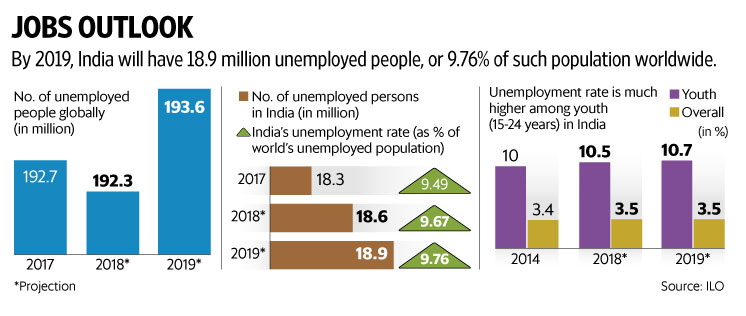Urban Employment Crisis | 15 Sep 2020
This editorial analysis is based on the article “Urban employment as the focal point” which was published in The Hindu on 15th of September 2020. It talks about the employment scenario in present times.
The contraction of the economy due to Covid-19 pandemic has raised concerns about the employment situation in urban areas. While the ‘Garib Kalyan Rojgar Abhiyan’ launched in June 2020 could be an immediate relief, the ₹50,000-crore employment scheme may not be a suitable substitute for decent urban jobs.
Further, the pandemic and associated policy responses (unplanned lockdown) have exposed the vulnerability of these urban jobs. Thus, for sustenance for the overall economy, there is a need for policy interventions to revive urban employment generation.
Threats to Employment
- Slowdown in Major Employment Generating Sector: The shrinking sectors that have been affected the most —construction (–50%), trade, hotels and other services (–47%), manufacturing (–39%), and mining (–23%) — are those that create the maximum jobs in the economy.
- Reverse Migration: The magnitude of economic slowdown can be exemplified by a wave of massive ‘reverse migration’ during the early phase of the lockdown whereby millions of workers returned to their home States due to a loss of livelihoods in cities.
- Vulnerable Informal Sector: According to the International Labour Organization, of the 535 million labour force in India in 2019, some 398.6 million have poor quality jobs. Further, the lockdown exposed the state of vulnerable employment in urban low-end informal jobs.
- Vulnerable employment is characterised by inadequate earnings, low productivity and difficult conditions of work that undermine the basic rights of workers.
- The high and persistent incidence of vulnerable employment are a reflection of the nature of the structural transformation process, whereby capital and labour transfer from low to higher value-added sectors.
- However, in India capital and labour are moving from low value-added activities in a sector to another sector, but not to higher value-added activities.
- This leads to a situation where a large proportion of the jobs being created is of poor quality.
- Increasing Number of Working Poor: Despite higher economic growth in recent years, working poors are increasing in India.
- The service sector-led growth in recent years has intensified this as there is coexistence of strong job creation in some Information and Communication Technology (ICT)-intensive services.
- However, along with a significant portion of the jobs being created in ‘traditional low value-added services, where informality and vulnerable forms of employment are dominant.
- The poor quality of jobs and high informality are key for the high level of “working poors”. The working poor are working people whose incomes fall below a given poverty line due to low-income jobs and low familial household income.
Way Forward
- Mobilising Localised Resources: Given the scale of urbanisation, the focus on urban employment generation programmes should be in coordination with local governments.
- This will require actors at the local level to have more resources at their disposal.
- Resource mobilisation could be enabled by the formation of local alliances, involving elected representatives, trade unions, entrepreneurs and community groups
- This can also be the key to solving other problems faced by cities.
- Localised Employment-Intensive Investment Policies: A major local initiative would be to design and implement employment-intensive investment policies. In this pursuit:
- Local enterprise formation needs to be an integral part of the strategy, with converging interests for workers and entrepreneurs on issues related to technology and productivity enhancement.
- Also, Small and micro enterprises which are the fulcrum of industrialisation, need extra support to balance the interests between labour and capital as neither have collective bargaining powers.
- Prioritising Urban Infrastructure: There is a need to prioritise urban infrastructure as it accounts for a large share of total investments in the overall economy.
- A labour- intensive approach to building municipal infrastructure can be a cost-effective alternative to capital intensive-approach as wage rates are low.
- Infrastructure investments would spur employment, generate earnings and contribute to small enterprise formation.
- Construction of low-cost housing is another activity that can be carried out using labour-intensive methods, while yielding substantial collateral benefits for urban dwellers.
- Launching of Urban Employment Scheme: There is need for immediate launch of an urban employment scheme oriented toward building large-scale medical, health and sanitation infrastructure in cities and towns across India.
- MGNREGA can be expanded for urban areas, both in terms of increasing the budgetary allocations and the guaranteed minimum number of days of work.
- Other immediate employment generation can be to expand networks of essential services as a part of welfare interventions of State and local governments.
- Increase Incentives to Reduce Migration: Focusing on rural development to increase employment opportunities in rural areas and to enhance the provision of services like education, health, electricity and water and sanitation services are effective means to control rural to urban migration.
Conclusion
Given the economic contraction, there is a need to generate more jobs and reduce vulnerabilities by providing decent wages & job security in urban areas. Thus, the present crisis calls for a multi-pronged strategy to tackle the issue of urban jobs.
|
Drishti Mains Question “The Covid-19 pandemic and associated policy responses have exposed the vulnerability of the employment scenario in India”. Discuss the statement and the role of localised interventions in resolving the unemployment crisis. |
This editorial is based on “Need to curb NSA misuse” which was published in the Financial express on September 12th, 2020. Now watch this on our Youtube channel.

